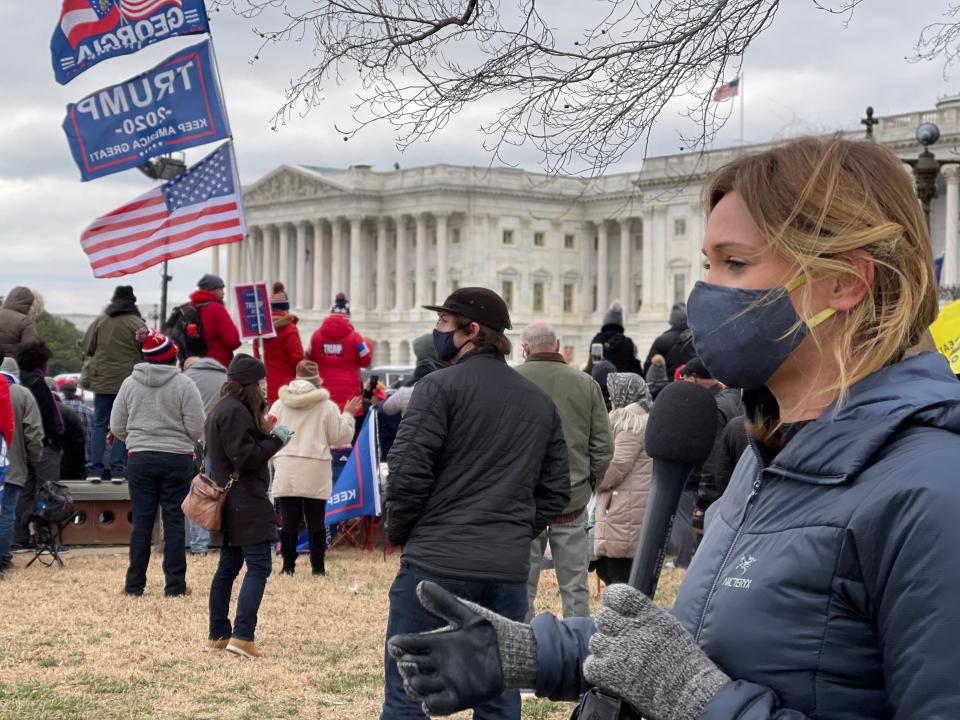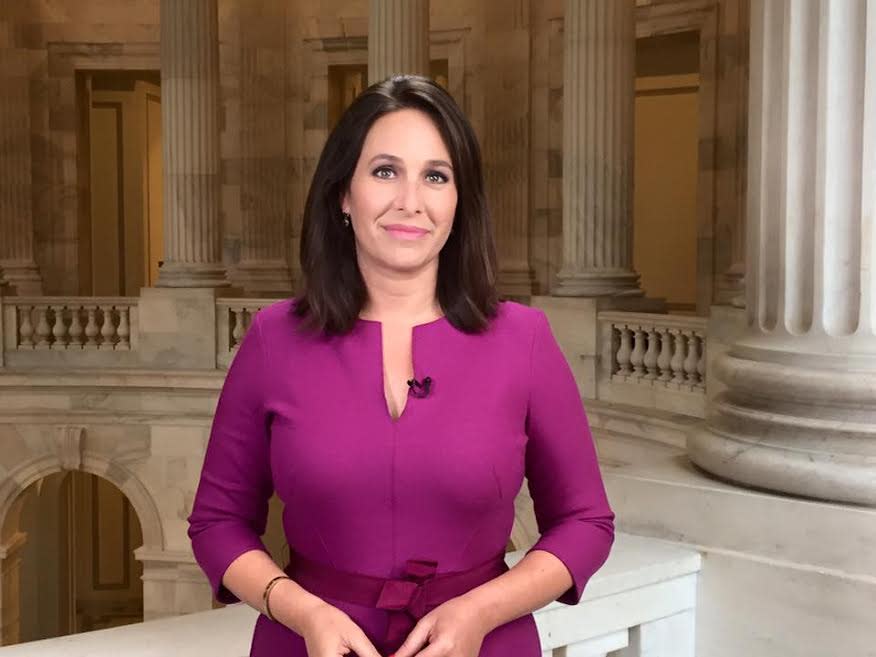‘We’re Still on Edge’: 3 Reporters on Witnessing the Riot at the Capitol
When Ellison Barber was assigned to report from the side of the Capitol building on Wednesday morning, she thought she was in for a quiet day. The action, she assumed, would be closer to the White House, near where the president was giving a speech about refusing to concede the election.
But in the next few hours, Barber watched and reported as explosive devices were found nearby, as members of the far-right Proud Boys marched past, and, ultimately, as a mob stormed the Capitol building, unchecked by the police. Five people died during the unprecedented riot.
Barber, a correspondent for NBC News and MSNBC, dodged harassment from rioters seeking to vilify the media, stepped over a puddle of blood, and ended her workday feeling the wet drops of tear gas on her face. She and other women reporters who were reporting at the Capitol during the January 6 historic insurrection attempt told Glamour what it felt like to be on the ground during one of modern U.S. history's most shocking moments.

Ellison-Barber-Capitol-Riots
Ellison Barber, NBC and MSNBC correspondent
The anger within that crowd was unlike anything I’ve ever seen.
I got there at 8 a.m. and we were assigned to the eastern side of the building facing the Supreme Court—at first I thought I drew the short end of the stick—I was thinking the Capitol was going to be really quiet! I talked in my first two news hits about how this was a peaceful but vocal group. Then we watched President Trump addressing the crowds from our phones, and around that time a group that we believed to be the Proud Boys passed through—they were wearing orange bands, shouting as they usually do, “Fuck Antifa” and “Uhuru,” which is one of their chants.
There were some skirmishes on the House side of the office building—I’d been in that exact spot back in June reporting on the protests associated with George Floyd, and I noticed the Capitol Police presence was a little lighter than it was back in June. I emailed Capitol Police, being like, “Are you going to add more people? Have you arrested anyone?” Around then, time became blurry—we went back to the eastern side of the building and suddenly it looked like a sea of people—they broke through the barricade and this sea of people, inch by inch, they pushed Capitol police back. I looked back at the stairs and Capitol police seemed to be gone. I’ve covered a lot of protests and a lot of weird things, and this was so surreal not necessarily because of what was happening—of course people are going to be out on the streets because they believe there has been this massive conspiracy—but it was so shocking how it happened.
About 30 minutes earlier, I had talked to a man in militia-like garb and I asked him what he thought would happen after the Electoral College votes were counted. He said, “I think it’s possible that a million armed men shows up to fix the problem. I hope to God that doesn’t happen, but if you don’t give people a legal way to solve their grievances, violence is always the result.” Some people weren’t armed necessarily to the level of what I think he was suggesting here, but to see that play out in the next 30 or 40 minutes as people stormed the Capitol was surreal. Anyone who came out claiming to be inside was greeted like a hero by the crowd. The pride that people had coming out…to witness that was very shocking.
We saw one woman—I don’t know if she’d been trampled, there appeared to be some blood—an EMS grabbed her and took her out of the area. There were flash grenades. We stayed with the crowd until the curfew. On one of the sides near the Senate building they started spraying what I think was pepper spray because it was a little wetter than tear gas.
There is this small group of people that we know have been so frustrated—they believe despite all the evidence against it, that it was a fraudulent election. There is nothing you can say and no discussion you can have with them about the facts where they will not tell you you’re wrong.
We knew within this group that there was a lot of anger and frustration, but still, in the moment of it, it was so surprising. Having covered protests there before, I had never witnessed anything like this.

Lisa Desjardins, PBS NewsHour Capitol Hill correspondent
I had expected it would be a long day, with a lot of waiting around and moving between chambers and hoping somebody says something interesting. Still, I brought two outfits to the Capitol with me, and I did it on purpose. It was weird because I was like, “This is going to be fine. I’m not worried about the rioters, but just in case….” Because I had gone to the Capitol dressed in my cute outfit—green mock turtleneck with a ruffle collar, windowpane pants. But I had this feeling. I knew that, with the mob, I was not going to fit in in that. So I brought another outfit with me—navy blue turtleneck, navy blue leggings, and a baseball hat.
The minute that I heard that the first building had been breached, even though all the police on the Capitol were actual casual, I was like, “I’m going to do an outfit change.” I was kind of joking about it, that I was doing this ridiculous thing, but I was so thankful that I did it. Because at some point, some of the rioters just passed me, and I didn’t stand out. I think it made a difference.
When I heard that the Cannon House Office Building was going into lockdown and that there could have been a security breach at the Madison Office Building, I walked over there to check it out and it seemed calm, but when I got back to the Capitol, with Capitol police still not knowing things were out of sorts, I started hearing noises. And I heard rioters banging on the front door, and I walked over and that’s when it became clear there was just a complete disconnect.
The first thing I wanted to do was get on air. There weren’t a lot of us there; it was just me and two other reporters and two Capitol Hill staffers. I realized I just had one phone, and I had to use that phone to either be on air or to take video of this historic violence. I had to be on air, so I screamed at the print reporter, who’s a friend of mine. I was like, Get video.
I’ve had hostile-situation training, and I’ve been in situations hostile to journalists before, so I know how to evaluate a space. I was in a very good operational location. I was in a marble balcony overlooking the front door, so I was a full staircase above where the rioters were coming in. I knew that I had enough time to get out of there if I needed to. But because the gap in the door wasn’t that wide, it was like one or two of them coming in at a time, and that was fortunate because it gave me time to talk to them, and I got one of them on air—one of the only interviews of a rioter when they were in the Capitol explaining what they thought they were doing and how they could possibly justify it.
It did get a little more hairy as time went on. As I turned around the corner after talking to those rioters, I was thinking, I know I’m going to head over to the House chamber now, and I was like, Okay, I know that there are four Capitol Police positions there, and I’ll see them and I’ll let them know that I’m cool, I’m media. I’ll be with them, and it’ll be a better space. I got to that place outside the chamber and all of the Capitol police, whom I’d seen minutes before, were gone. There was part of me in that moment—my heart wanted to drop.
I ended up with the SWAT team after a while, and then I got evacuated down the stairs with the members of Congress. During that evacuation, I was talking to Representative Norma Toress of California, and we just had a brief conversation. I said, “Where in the realm of any reality is this to you?” And she looked at me—and it’s a little emotional for me to talk about even now—she said, “I’m from Guatemala, and this is why I left that country: hostile takeovers of government.” You could tell that she was scared, and I had to calm her down and I had to be calm too. But she was right. I couldn’t believe it either.
I woke up this morning, and my first thought was like, Wow, that really happened.
I think the inauguration is something that there’s a lot of concern about. They are now changing security at the Capitol. They’re putting up seven-foot-tall fences, which I think will be helpful but makes me sad. It’s something that I would usually bristle at, but it will be needed potentially. I mean, the president certainly has not discouraged this violence. Sometimes he’s smiled at it. The question is: Will he encourage further action or will there be a subgroup of violent extremists that go even more rogue? I hope that I’m wrong, but I think at this point we have to be ready. This kind of cancer that’s in part of the American soul is there pretty firmly right now. I’m not sure people realize the depth of the mindset of the people who perpetrated this. Talking to them, I could see they are completely disconnected from reality and they are completely convinced that anything they do is right, including serious violence.

Nancy Cordes, CBS News chief congressional correspondent
My biggest concern when I woke up on Wednesday was whether I was going to have enough time to cram every possible fact about the electoral certification process into my brain in time for the 1 p.m. process to begin. We had not gotten a lot of sleep because the Georgia runoffs took place on Tuesday, so I was now planning to turn my attention fully to the Electoral College tally, which is something that I’d never really been focused [on] in the past because it had typically been a formality. This time was obviously going to be different.
The first sign that something was unusual was when I was driving to the capitol at 6:30 in the morning, as I always do, I noticed that even though it was pitch-dark outside, there were already hundreds of people walking around in groups on the street. They were in a good mood and laughing and joking, wearing MAGA hats and carrying Trump flags and American flags, which was a really unusual sight, not just because it was still pitch-dark and the rally was hours away, but also because we’ve been in the middle of a pandemic and the city has more or less been a ghost town.
There was an exact moment when I realized this was more than just unusual. I was watching the debate on the Senate floor and Mitch McConnell had just given his speech about why Congress should not contest the Electoral College results. Then Chuck Schumer spoke and a couple of others. I knew there were protestors outside the Capitol. I could hear them. I could see them. But they still weren’t my primary focus. I was still focused on the story that I was covering, which was the Electoral College results, but as I was watching the debate from where I was in the Russell Senate Building, I saw security officers rush in and grab Chuck Grassley—the senator from Iowa who is also fourth in line for the presidency—and rush him out of the room, and then I saw aides who were there on the dais wave their arms as if to motion to the senators who were in the chamber as well to get down. And then a slate went up that said the Senate was in recess. After that I couldn’t see what was happening on the Senate floor. And that was the first indication that something had gone really, seriously wrong and what became clear very quickly was that these rioters had managed to break into the Capitol building itself. They were not just in the hallways of Congress, but they were right outside the Senate chamber.
Anyone who has covered Capitol Hill before has seen large-scale protests. That’s a fixture of Capitol Hill. What was so shocking and so unexpected was these were not individuals who were looking to make a point and get attention, which is something that we see all the time; these were individuals who were determined to break into the building, go to very sensitive locations where the public is never allowed to go unescorted, and it wasn’t really clear what point they were making. It seemed like the incursion was the point. And that is just something we have never witnessed before.
When we returned later for the vote, which stretched into the early hours of the morning, yes, a handful of elected officials changed their minds, particularly Republicans in the Senate, but most Republicans in the House didn’t. You still had a majority of them, including their leader, Representative Kevin McCarthy, vote in favor of rejecting the Electoral College results from one state or more. In that sense they really didn’t change their positions.
Even a few days later, I think that everyone is still on edge because there is a fear that we’ve got an inauguration coming up in 12 days, and it’s frightening to think that people could come back and try to disrupt the inauguration, which is being held in the very same location where you saw all of these people scaling the walls.
These interviews have been edited and condensed.
Jenny Singer is a staff writer at Glamour.
Matie Kahn is the culture director of Glamour.
Originally Appeared on Glamour

